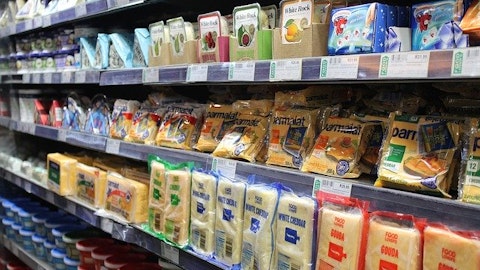Kevin Hourican: Thank you, Mark.
Operator: Your next question will come from Edward Kelly of Wells Fargo. Please go ahead.
Edward Kelly: Hi guys. Good morning. I wanted to follow up on the cost side and what’s embedded in the guidance again. I know when you set your initial guidance this year, there €“ the low-end incorporated some risk of a, I guess, modest recession. Obviously, the definition of that is debatable. But it does seem like the revision has a lot more to do with the cost side. And my question for you is, how much improvement is embedded from here from a cost perspective? And how much visibility do you have on achieving that improvement, which, ultimately, sort of relates to how confidence in your guidance at this point with this adjustment. And then, as a follow-up to that, how does what’s happening in 2023 reflect the goal of 462 plus in fiscal 2024 from an EPS standpoint? Thank you.
Kevin Hourican: Ed, good morning. Thank you for the question. As it relates to OpEx I repeat a couple of the numbers that Neil communicated and then provide a little more color on why we have confidence in our ability to drive the improvement in the second half of the year. Toss to Neil for any additional color or comments about the overall confidence that we have in the forecast for the year. Snap back has been taken to 0, and that was a material number a year ago and big progress has been made. We’re no longer needing to do things like hiring bonuses and referral bonuses and the marketing spend that we were doing to create awareness of jobs. So Snapback has gone to zero. The productivity piece, and that’s specifically measured as excess over time, if you will, has gone from $41 million in Q1 to $22 million in Q2 and we expect for that to continue.
I point you to Slide 9, Ed, and I put that chart in there on purpose to show you the progress in the collective community, the progress we’re making on retention improvement and how that retention improvement will, therefore drive transportation, as well as warehouse operations metrics. We have finite data, real-time data, weekly data, I host a weekly call, talking about our productivity at the site level that all of our key leaders attend and we have a firm understanding of where we are and where we need to be week-over-week, month-over-month, quarter-over-quarter to hit the full year. So we updated our guidance today to reflect the fact that, yes, our operating costs in the second half of the year will be higher than what we originally budgeted, but an improvement from where we stand here today at the end of Q2 and we’re seeing the progress that needs to be made in order for us to be able to deliver the full year and it has my personal full attention and the full attention of all of our leaders Neil will toss to you for any additional comments.
Neil Russell: Thanks, Kevin. Hey, Ed, good morning. Two things, Ed. First of all, on the FY 2023 portion of your question, we completely rebuilt the forecast as part of the process here and gratitude to the finance team for all the good work over the last several weeks to do that. As I alluded to, we feel very good about a few things that we rebuilt and are in there. As Kevin alluded to in his comments, the labor activity expense impact of $26 million is in the rearview mirror, but obviously, that factored into the adjustment that we did. The pension expense that I just spoke about, we remeasured the plans, we have high confidence and what we think those numbers will be going forward. I also mentioned things like the productivity and snapback cost that Kevin just alluded to that we feel very good about the turning point, if you will, that we see on those types of cost items.
So we looked at the market, we looked at everything we have, and we have pretty high confidence in the numbers in which we’re offering to you for the rest of this year. As it pertains to the second part of your question for next year, fiscal 2024, we’re at the halfway point here in FY 2023. We feel really good about the progress we’re making across the enterprise. We continue to gain share as we’ve talked about. We’re driving really compelling returns through the Recipe for Growth initiatives including a lot of really good operating efficiency. That’s part of the slide Kevin referred you to and our long-term plans reflect double-digit growth in both top and bottom line and along the way, we’re returning a lot of value to shareholders through the dividend, share repurchase and of course, the profit growth.
So we would typically update the next year during the summer as we look at the end of year results for us and that will be our plan for now. So we’ll take a look at fiscal 2024 numbers when were port our end of year 2023 numbers.
Edward Kelly: Thank you.
Operator: Your next question will come from Jeffrey Bernstein of Barclays. Please go ahead.
Jeffrey Bernstein: Thank you very much. Just following up on the most recent softening you mentioned. I know there was some talk about how operating expenses have perhaps surprised you to the upside. I was hoping the shift to the market volume softness you mentioned. Just wondering how much of that you think is unique to Sysco or perhaps unique to specific product lines or geographies? I know you mentioned that you’re still outpacing the industry, but it doesn’t seem like the restaurants or other customers that we hear from are really talking about as lowdown and in fact, we’re talking about a little bit of a benefit from the Omicron lapse. I am just wondering if you can offer some detail on where you think the the softness came from and then whether your guidance assumes softness continues. I know you said January is looking better. I wasn’t sure whether you’re extrapolating that better January trend in the back half of the year assumption. Thank you.
Kevin Hourican: Hey Jeff, thanks, it’s Kevin. I’ll start with your question. Just as it relates to Sysco versus the market, I’ll just point to the most important of facts, which is that we grew in the most recent quarter, 1.35 times the market. So it is €“ Sysco is outperforming versus the market and that outperforming is coming from across the board, business health. We are winning meaningfully in the CMU segments: Education, healthcare, contract bid within the restaurant sector and the gross profit rate and that sector has also been strong and has been ahead of where we expected it to be. At the local level, our business performance in total is being driven by our core growth initiatives within local that I referenced earlier.
So this is not a Sysco-specific situation. It is a macro and we’re actually pleased with our performance relative to the market. The only thing in the most recent quarter that was specific to Sysco was the labor dispute in three of our sites, which meaningfully pressured our operating expenses. We’ve size that for the investment community today to communicate. That was a $26 million operating income hit for the quarter, which was a combination of expenses and also sales and therefore, flow through to margin impact from the three markets that were impacted by that labor disruption. So as it was called out by one of the other questions earlier on this call, our Q2 growth versus the market was a little bits lower than our Q1 growth, but we still grew meaningfully versus the industry.
As it relates to the second half of the year and then I’ll toss to Neil if he has anything additional. We have been thoughtful about the full year volume. As Neil said, we took a big step back at the midway point, turned over every rock, looked at every component of our build of the full year budget and compared it to the trends of the business performance and we applied for the second half of the year, the trends of our business with known trend vendors that we – Sysco can positively impact, the operating expense that Ed just asked about is a projected improvement in the second half of the year. But we’ve been thoughtful about volumes looking at the second half. And no, the January strength I referenced was not contemplated at the time that we built that second half.
The Omicron tailwind will abate here quickly in February. As you know, things began to reopen in the middle of February to the tail end of February and the forecast adjustment that we provided today is our best view of the full year center of the fairway, as I mentioned. Neil, over to you for any additional comments.
Neil Russell: Yes. Thanks, Kevin. Hey, Jeff, good to hear from you, as well. Just a couple of points from me. To answer your question, yes, we have factored in current performance to the year-to-go guide. One additional item I would point out to you is we’ve had improvement in our Sysco brand penetration, which we’re very pleased with. That team has been doing a very good job, further penetrating both current accounts and new accounts with our Sysco brand product, which, of course, is a higher-margin product. So we see that momentum we’re factoring that into our guide as well. So we do have good confidence in the year to go look that we have in the numbers we offered and just a reminder for those, the guide, the midpoint that we offered today is a 25% year-over-year growth and a 15% growth over 2019. So we like what we see there and we have really high confidence in that guidance.
Operator: Your next question comes from John Heinbockel of Guggenheim Securities. Please go ahead.
John Heinbockel: Hey, Kevin, a couple of things. On the local business, what are you seeing with drop size and profitability per stop right? What are the trends there? What’s the thought on the your way rollout, right? How quickly can you roll that out? I know the target was to get to $1 billion of incremental revenue, how quickly can that be done? And then just lastly, the contract bid. I know that’s very lumpy. Do you think that is abnormally €“ the opportunity abnormally large over the next year or pretty much in line with what it had been?





